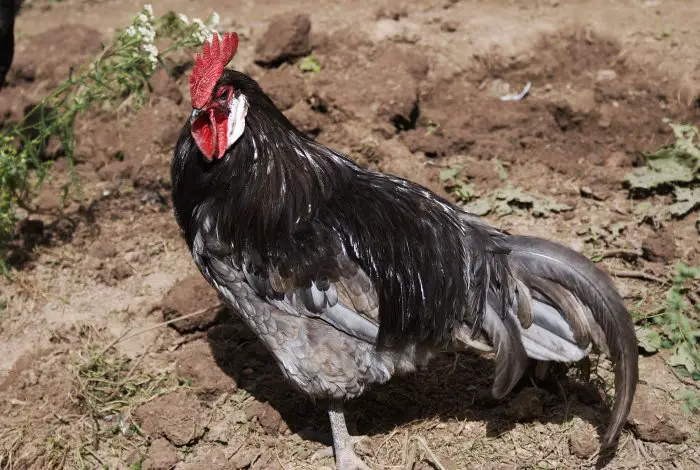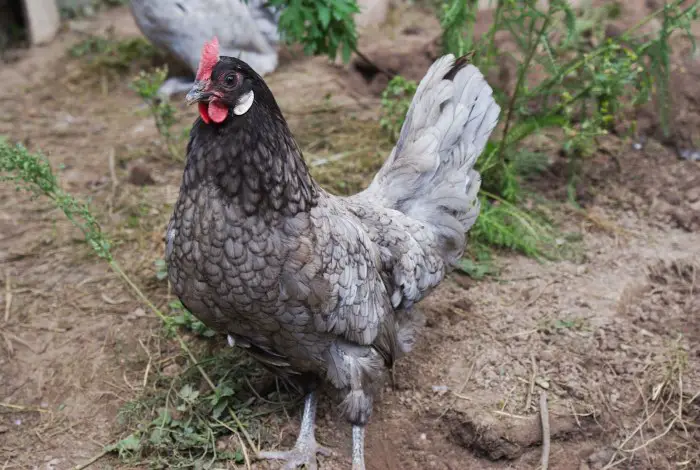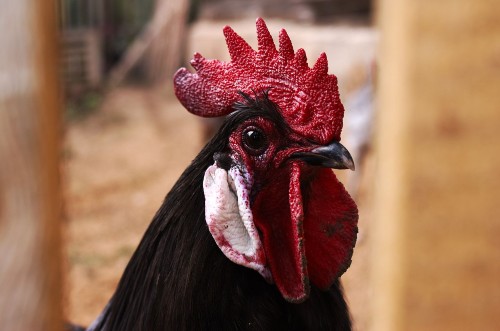While the Andalusian chicken as known as Blue Andalusian has never been one of the most popular chicken breeds in the world, it is one of those rare breeds that has managed to last a good while.

The current blue Andalusian chicken can be traced back to the middle of the 1800s, but it is likely that this breed was around for a long time before that.
Let’s take a little look at this breed in a bit more depth.
The Andalusian Chicken Facts at a Glance
| Eggs | ~160 per year |
| Egg Color | Chalk-White |
| Use | Eggs |
| Comb Type | Single |
| Weight | Male Standard: 7 lb.(2.3 kg) Male Bantam: 28 oz (795 g) Female Standard: 5.5 lb. (2.5 kg) Female Bantam: 24 oz (680 g) |
| Country of origin | Spain |
The Origin of the Blue Andalusian Chicken
As the name suggests, this is a chicken that originated in the Andalusia region of Spain. In fact, this is the area where you will still be able to find the vast majority of them.
It is a popular breed of chicken there. We do not know how these chickens actually came to be in Andalusia. After all, this sort of thing wasn’t spoken about all that much.
One interesting theory, based on some history papers, says that a very similar chicken is described in ancient Rome. So maybe this chicken came from there, no one actually knows. However, if we had to guess, we would say that these chickens have been in Andalusia for a good few centuries now.
Obviously, we have no idea which breeds they were bred from. This is information that we are unlikely to ever know, mostly because it is likely that the bulk of breeds that went into the Andalusian died out a long time ago.
The part of history that we are most concerned with is how they got from Andalusia to the rest of the world. We can actually trace this back to around 1860.
They were brought over to market in the United Kingdom and sold there. Interestingly, British breeders tried to go in a different direction to the one that was imported. Although, the breed didn’t change all that much. Not enough for it to be a distinctive breed.
However, chickens that originate in Andalusia are slightly different to the chickens that are bred in the United States and United Kingdom, although probably not enough for you to worry that much about where your chicken came from.
Do You Want Big Beautiful Eggs?
Then you must check this ORGANIC & NON-GMO feed. Our hens lay jumbo eggs now and they love this feed! You can check it right here on Amazon.
The Graceful Look of the Andalusian Chicken

The Andalusian Chicken weighs somewhere between 5 and 7lbs, dependent on whether you have a rooster or a hen.
This is a very ‘graceful’ looking bird. While it is a rather small bird in the grand scheme of things, this is one of those rare breeds that likes to stand tall and proud. Due to its stance, it may actually look a little bit heavier than it actually is.
The single comb is going to be a bright red color and, honestly, it is going to be one of the most beautiful looking combs you have ever seen.
It is stunning. It has five points. The comb will stand a little bit differently, dependent on whether you have a rooster or a hen, but it is certainly going to stand out no matter what!
The Andalusian Chicken is, traditionally, a blue chicken breed. The blue Andalusian chicken is the only recognized variety of this fowl. This is due to a faulty gene. However, there are ways that you can correct this gene through selective breeding. This means that white, black, and fully blue birds are available.
Although, do bear in mind that breeding out the trait is only going to be temporary.
That faulty gene will return when you breed again!
The Meat of the Blue Andalusian
The Andalusian Chicken is a bit on the smaller side. This means that it isn’t really raised for the meat that it produces. Obviously, there are people who will slaughter the blue Andalusian fowl for meat purposes, but this is going to be exceedingly rare outside of Andalusia.
There are far better meat chickens out there.
That being said, some people have claimed that the blue Andalusian offers some of the best meat that they have ever tasted on a bird, so if this is your sort of thing, you may want to try it at least once!
Blue Andalusian Chicken Eggs
A lot of this is going to be dependent on where your chicken comes from. However, no matter what, you shouldn’t expect your Andalusian Chicken to lay more than 160 eggs per year.
So, you should be getting one a little over every two days. These will be eggs on the larger side of things, which is always going to be a plus. However, you cannot rely on the Andalusian Chicken to provide consistent egg laying. There are far better chickens raised for eggs out there.
Andalusian as a Show Chicken
Nowadays, the bulk of Andalusian chickens are raised for show purposes, as show chickens. It is the fully blue chickens that are needed for chicken shows.
It is unlikely that you will be able to find a chicken show for one of the other types. It is also very rare to find shows outside of Spain.
The Personality
The blue Andalusian is a chicken that hates to be touched. Do not ever touch your Andalusian. They will peck at you.
However, for the most part, this is going to be quite a friendly breed of chicken for you to enjoy. One of the main reasons as to why people pick up the Andalusian Chicken is that they are fantastic to watch.

They love being out in the open and exploring. So if you want a chicken that isn’t necessarily productive, but is going to be fun to watch, then the Andalusian chicken may be a good option for you.
Andalusian Chicken Care Tips
The only main issue you will have with the Andalusian Chicken will be during the colder months of the year. As we said before; this is a chicken that boasts a beautiful comb.
However, the problem is that this chicken comb type is going to be on the larger side of things. This means that in colder areas, it will suffer from frostbite.
So, this is one of those breeds of chicken that we wouldn’t raise if you live in an area that gets a lot of snowfall. Remember; this is a breed that originated from one of the hottest regions in the world, after all.
Other than this, there are not any major issues with the bird, and it is going to be a tremendous amount of fun raising them. You just have to remember that they will not be that productive.

